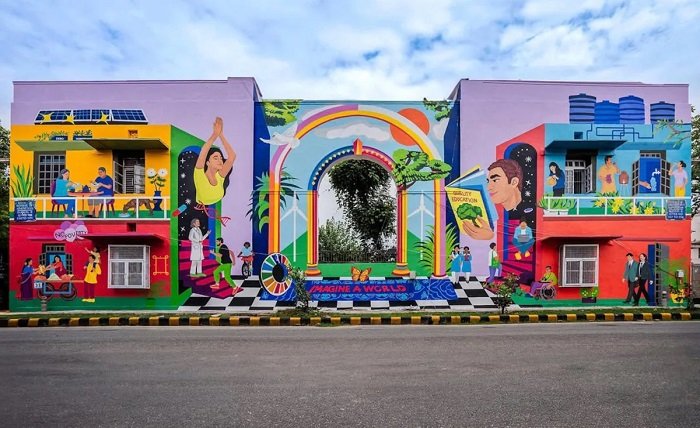Street poetry and public art are no longer side notes in India’s cities; they are becoming central voices. Murals, verses, and spoken word collectives transform walls, pavements, and metro stations into platforms where culture, resistance, and creativity intersect.
Risk and Resistance: The Courage of Public Expression
India The government in India has been known to put risk on public art. Putting up a mural or performing poetry in a crowded marketplace is a challenge to social norms and even political boundaries. It is not necessarily about decoration but facing problems, such as inequality, gender, migration or environment, that are often silenced in mainstream arenas.
An example is the graffiti in Delhi Hauz Khas Village or writings on Kolkata tram walls which provide a democratic level to the stage. These works occasionally wind up the subject of controversy, such as municipal crackdowns to social criticism. However, that aspect of risk brings urgency to the message.
The voice of street poets reverberates to this. Bengaluru and Mumbai slam poetry movements are bringing young people into the spotlight, and their poetry is filled with humor, rhythm, and metaphor to challenge injustice. For those seeking curated collections of such urban voices, this website often highlights resources where the intersection of creativity and risk-taking becomes visible across India’s cultural landscape.
The Role of Cities as Living Canvases
India is an urban city that offers the best environment to express art. Urban centers are overlaid with contradictions that are heritage buildings adjacent to glass towers, luxury shopping malls with street markets full of people. Poetry and public art can be found in these transitional spaces and get the pulse of everyday life.
The metro stations of Bengaluru have been painted with history and poetry of the region making the daily commutes a cultural experience. Pune has walls plastered with quotes by the Marathi poets serving as reminders to people about the literary origins of the region. Even in smaller towns such as Kochi which has its own street art inspired Biennale you see that art is not confined to galleries.
Cities are not neutral spaces; they’re contested and alive. By turning them into canvases, artists reclaim ownership of their environment. This creates a dialogue between citizens and their surroundings, making art part of urban identity rather than something distant or elitist. The act of engaging with poetry on a wall or mural reshapes how people view their city.
Street Poetry as a Reflection of Society
The concerns of the society are reflected in street poetry which is either written on the streets or displayed on buildings through projection. In contrast to published works, these verses are not polished, not immediate and anonymous. They talk about the increase in unemployment, mental health issues, the safety of women, or climate fears using the words that immediately speak to the people.
In Mumbai, Poetry on the Streets uses readings in the streets to invite strangers into a common emotional space. Spontaneous park open mics in Delhi provide a platform of safety to the marginalized. These are all inclusive expressions, which attract both veteran writers and those who are performing for the first time.
Street poetry is powerful because it is accessible. No tickets, gates or hierarchies. Any passer-by can stop, listen, or interact. In the age of divided attention, such public poetry makes its demands on presence. It transforms common surroundings into venues of contemplation, in which common people identify with the situations that directly impact upon them, beyond the world of academia or literary elitism.
Technology, Social Media, and Amplification
Street art and poetry may begin in physical spaces, but their impact multiplies through technology. Social media platforms such as Instagram and YouTube allow murals and live performances to reach millions. A verse written on a wall in Jaipur can resonate with someone in London within hours.
Digital gain also promotes cooperation. Artists stream live performances, photograph graffiti before it is painted over and make online archives that can be studied in the future. Movements like #PoetryInPublic shows how hashtags bring global visibility to local art.
At that, it is also interesting that technology has been used to blur the lines between permanence and ephemerality. Augmented reality apps currently enable citizens to scan murals and be presented with several layers of interactive poetry or videos. This mixing of the analog creativity and the digital innovation keeps younger generations interested in the art so it does not just die with its physical boundaries.
By doing so, urban poetry and public art is no longer relegated to a corner of the street-it now becomes part of a world discussion on the issue of identity, voice and freedom.
Conclusion
Street poetry and street art in India are the examples of how creativity meets the bravery. Such phrases contest borders, take back cities, and speak to the people that would otherwise be silent. Whether this is in metro stations, festivals, or in busy markets, poetry and art transforms cities to become living stories.
The danger is implicit in such acts and it is due to this danger that they present power. By entering the streets, poets and artists state that culture is not the preserve of the rich only. Through the use of technology these voices reach even farther, inspiring the world but remaining grounded in local context.
After all, it is India with its street poetry and art that reminds us that walls can talk, pavements can educate, and lines can alter the way society views itself.
